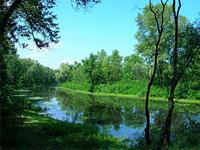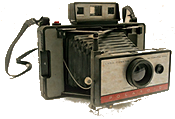Parks & avenues |
Botanical Garden of the Ukrainian Academy of Science
In Kiev, there are several botanical gardens: the one named after academic Fomin, the State Botanical Garden, and the Botanical Garden of the Ukrainian Academy of Science. The last one is probably the most picturesque garden in Kiev: the garden not only contains various kinds of plants, but also neighbors with the beautiful Vidubitsky monastery.
The Botanical Garden of the Ukrainian Academy of Science is also called the Central Botanical Garden. It was founded in 1936. Its total area equals 130 hectares and contains over 13,000 kinds and sorts of trees, shrubs, flowers and other plants from all the world continents. The Botanical Garden boasts a great amount of coniferous trees, flowers, such as peonies, roses, magnolias, and bushes, like lilac, locust and many other plants. The garden contains a number of hothouses, conservatories, greenhouses and rosaries. It is the place where the guests can see exotic plants, attend the flowers exhibitions, take a walk along the beautiful lilac and rose alleys, enjoy the exquisite scents and aromas.
Close to the Botanical Garden of the Ukraine Academy of Science there is a majestic Vidubitsky monastery, which was founded by the son of Yaroslav Mudry, Vsevolod, between 1070 and 1077. The name of the monastery comes from old Slavic legend about the pagan god Perun, who swam out of the Dnepr River, but was defeated by Prince Vladimir, who was against pagan idols and made Russia an Orthodox country. "Vidubat" means "swimming out" in Old Slavic, thus the name of the monastery constructed on the legendary site of Perun and Vladimir battle. In the times of Old Rus near the monastery used to be the passage through the Dnepr River. Vidubitsky monastery got its modern look in the 18th century, when the five-domed Georgievsky Cathedral, the refectory and the belfry were put up. They are examples of the Ukrainian baroque architectural style.
The Central Botanical Garden and adjoining Vidubitsky monastery create a charming and unique corner of Kiev, which is perfect for family rest or spending some time alone with nature and surrounding beauty.
In Kiev, there are several botanical gardens: the one named after academic Fomin, the State Botanical Garden, and the Botanical Garden of the Ukrainian Academy of Science. The last one is probably the most picturesque garden in Kiev: the garden not only contains various kinds of plants, but also neighbors with the beautiful Vidubitsky monastery.
The Botanical Garden of the Ukrainian Academy of Science is also called the Central Botanical Garden. It was founded in 1936. Its total area equals 130 hectares and contains over 13,000 kinds and sorts of trees, shrubs, flowers and other plants from all the world continents. The Botanical Garden boasts a great amount of coniferous trees, flowers, such as peonies, roses, magnolias, and bushes, like lilac, locust and many other plants. The garden contains a number of hothouses, conservatories, greenhouses and rosaries. It is the place where the guests can see exotic plants, attend the flowers exhibitions, take a walk along the beautiful lilac and rose alleys, enjoy the exquisite scents and aromas.
Close to the Botanical Garden of the Ukraine Academy of Science there is a majestic Vidubitsky monastery, which was founded by the son of Yaroslav Mudry, Vsevolod, between 1070 and 1077. The name of the monastery comes from old Slavic legend about the pagan god Perun, who swam out of the Dnepr River, but was defeated by Prince Vladimir, who was against pagan idols and made Russia an Orthodox country. "Vidubat" means "swimming out" in Old Slavic, thus the name of the monastery constructed on the legendary site of Perun and Vladimir battle. In the times of Old Rus near the monastery used to be the passage through the Dnepr River. Vidubitsky monastery got its modern look in the 18th century, when the five-domed Georgievsky Cathedral, the refectory and the belfry were put up. They are examples of the Ukrainian baroque architectural style.
The Central Botanical Garden and adjoining Vidubitsky monastery create a charming and unique corner of Kiev, which is perfect for family rest or spending some time alone with nature and surrounding beauty.
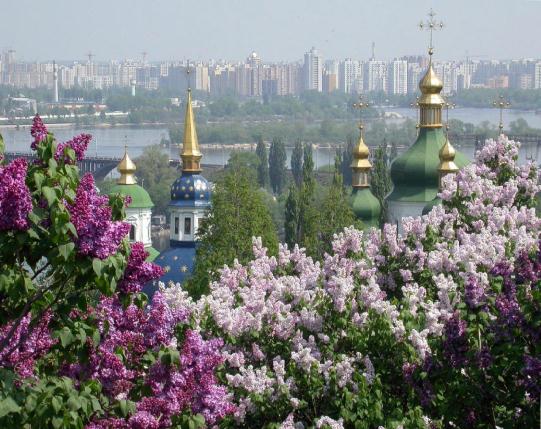
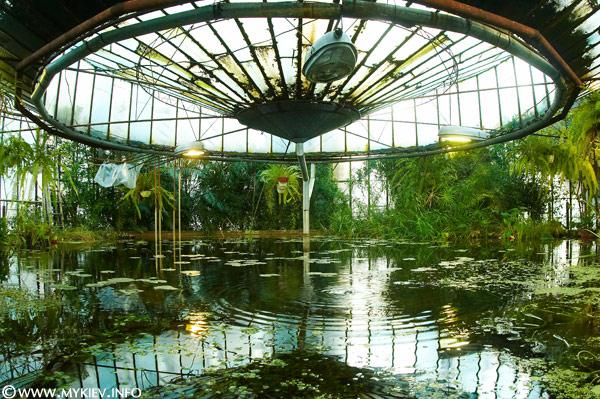
Hydropark
Hyrdopark is a very nice place, where the guests can find several clean beaches, restaurants, sport grounds, various roller coasters for kids, walking zones and other entertainments. The Hydropark features a unique sport ground under the open air. This is very attractive for those who follow a healthy way of life. Hydropark often holds various unusual exhibitions, especially during late spring and summer. For example, the contest of sand sculpture regularly takes place on one of the Hydropark beaches. It is a very notable event in Kiev cultural life, and usually sculptors from many countries of the world participate in the contest. In the Hydropark various music concerts and festivals often take place, so this cozy corner of Kiev is full of fun and amusements.
The island that now is called Hydropark appeared as a consequence of floods of the 19th century. Because of frequent floods, the citizens of Kiev called this place Venice. In the 60s of the 20th century the territory of the modern Hydropark, the total area of which equals 188 hectares, was equipped with beaches and rest zones. The park is connected with the rest of the city by means of ferroconcrete bridge 144 meters long. Those who seek extreme feelings like to jump from the bridge to the Dnepr waters, but the guests who prefer less dangerous entertainments will also find occupation for his or her taste.
The Hydropark is an ideal place for a family rest, as it contains beaches equipped especially for the little kids, who enjoy water chutes and other attractions. Visitors to the park are welcome to rent a boat and flow along the river, admiring picturesque landscapes and enjoying romantic atmosphere. Those who like speed can rent a motor launch or try water skiing. When one is tired, he or she can choose from a large variety of bars, cafes and restaurants. In the evening the park turns into a disco zone: the nightclubs attract with their neon lights, and sometimes the parties take place under open air, which is especially pleasant during dark and warm nights.
The Hydropark gives an impression of a careless resort, where all the visitors, regardless their age, have a good time and enjoy their leisure. This place could be called the water kingdom, where all kinds of water amusements are available.
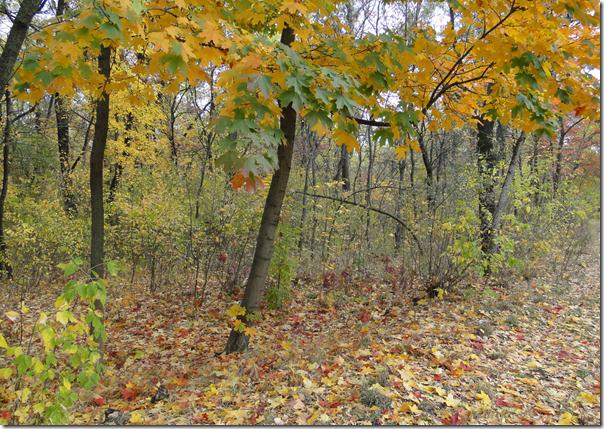

Kiev Zoo
Kiev Zoo was founded in 1908 by the Nature Lovers Society and financed by private donations. At the beginning the zoo experienced difficult times and could not boast a great amount of animals: there were just 17 kinds. The first winter the animals had to spend in the food department of the main Kiev railway, as the zoo founders did not find a shelter for the animals they possessed. For a short time the zoo inhabitants lived in the University Botanical Garden, but each month the quantity of animals was increasing, there were not enough space for all of them, and sometimes some of them frightened the university students and professors. Only 4 years after the zoo foundation it was given a relatively large area on the outskirts of the city.
In 1913 the animals celebrated the house-warming. In 1914 the zoo greeted its first guests, but the Civil War and the World War I put obstacles in the way of the zoo development. Only in the 20s the zoo was reborn. During the World War II the territory of the zoo was occupied by German military garrison, as for majority of animals, they were evacuated beforehand. After the end of the war the animals were returned to Kiev, all the cages were restored and renovated. The birds pavilion, open in 1970, was considered to be the largest in Europe. In 1982 the guests to Kiev Zoo could see the animals island, which was separated from the rest of the zoo by wide ravines and housed tigers and lions. In 1996 Kiev Zoo was included in European association of zoos and aquariums.
Nowadays the zoo is located in the center of the city and occupies the territory of 40 hectares. The landscape relief allows all the zoo inhabitants live in comfortable conditions. The collection of Kiev Zoo numbers over 2,000 fauna representatives from all over the world, including mammals, birds, snakes, fishes and insects. The zoo boasts a pair of elephants. Over 130 kinds of trees and bushes decorate the zoo lands.
Kiev Zoo also serves as a scientific research center, where the specialists work on acclimatization of the far lands animals, preserving and reproduction of rare animals, such as Amur tiger, bison, Przhevalsky horse and some others.
Kiev Zoo was founded in 1908 by the Nature Lovers Society and financed by private donations. At the beginning the zoo experienced difficult times and could not boast a great amount of animals: there were just 17 kinds. The first winter the animals had to spend in the food department of the main Kiev railway, as the zoo founders did not find a shelter for the animals they possessed. For a short time the zoo inhabitants lived in the University Botanical Garden, but each month the quantity of animals was increasing, there were not enough space for all of them, and sometimes some of them frightened the university students and professors. Only 4 years after the zoo foundation it was given a relatively large area on the outskirts of the city.
In 1913 the animals celebrated the house-warming. In 1914 the zoo greeted its first guests, but the Civil War and the World War I put obstacles in the way of the zoo development. Only in the 20s the zoo was reborn. During the World War II the territory of the zoo was occupied by German military garrison, as for majority of animals, they were evacuated beforehand. After the end of the war the animals were returned to Kiev, all the cages were restored and renovated. The birds pavilion, open in 1970, was considered to be the largest in Europe. In 1982 the guests to Kiev Zoo could see the animals island, which was separated from the rest of the zoo by wide ravines and housed tigers and lions. In 1996 Kiev Zoo was included in European association of zoos and aquariums.
Nowadays the zoo is located in the center of the city and occupies the territory of 40 hectares. The landscape relief allows all the zoo inhabitants live in comfortable conditions. The collection of Kiev Zoo numbers over 2,000 fauna representatives from all over the world, including mammals, birds, snakes, fishes and insects. The zoo boasts a pair of elephants. Over 130 kinds of trees and bushes decorate the zoo lands.
Kiev Zoo also serves as a scientific research center, where the specialists work on acclimatization of the far lands animals, preserving and reproduction of rare animals, such as Amur tiger, bison, Przhevalsky horse and some others.

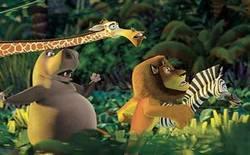
Trukhanov Ostrov
Trukhanov Ostrov is one of the favorite places of Kiev citizens and guests to the city. They come here to spend their leisure and enjoy the company of each other. On Trukhanov Ostrov there are the best and cleanest city beaches, which make the place an exciting oasis in the middle of the city hustle and bustle. Just like every resort place, it contains numerous cafes, bars, restaurants and other leisure places.
Trukhanov Ostrov is an island connected with the city by means of the Parkovy pedestrian bridge. The island is a paradise for fishers who enjoy sitting on the banks of the river and admire beautiful landscapes. There are numerous stories the fishers tell each other concerning great catch and unbelievable sizes of fishes they caught on the Trukhanov Bridge. The fishers believe that the island is a very lucky place.
The name Trukhanov Ostrov probably comes from Tugor-khan, who won a victory over Kiev Prince Svyatopolk II and made him marry his daughter. The summer residence of the princess was located on the island that was called in honor of her father. Several years later Tugor-khan was killed in a battle and buried in Berestov, close to the site where Spaso-Preobrazhenskaya Church is located nowadays. Historians suppose that on Trukhanov Ostrov in 1103 Kiev Rus princes gathered to discuss their united efforts against the tribes of Polovtzi. Later the island belonged to the Pustinno-Nikolsky monastery, but at the end of the 18th century the lands were passed to the state treasury.
Until 1957 those who wanted to get to Trukhanov Ostrov had to hire a boat in the summers or cross the river by ice in the winters. In 1957 the Parkovy Bridge was constructed, and Trukhanov Ostrov gradually turned into fashionable place for a rest, and it still remains as such. There are counsels to turn the territory of the island into a huge entertaining center, supply Trukhanov Ostrov with a subway station and a rope-way. Probably the island will be changed soon, but until those times it will gladden the guests with plenty of flowers, trees and water.

